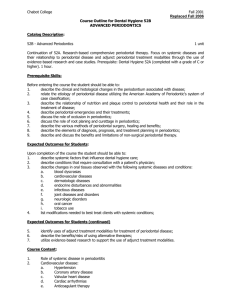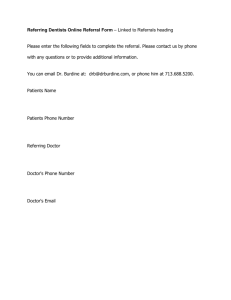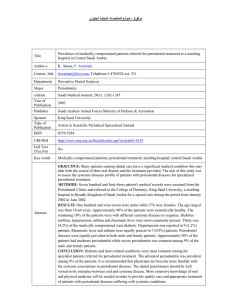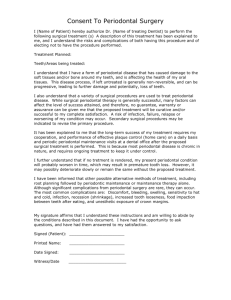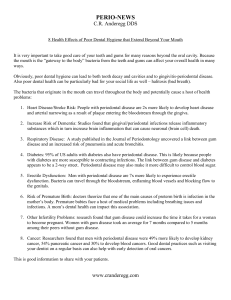Chabot College Fall 2006 52B - Advanced Periodontics
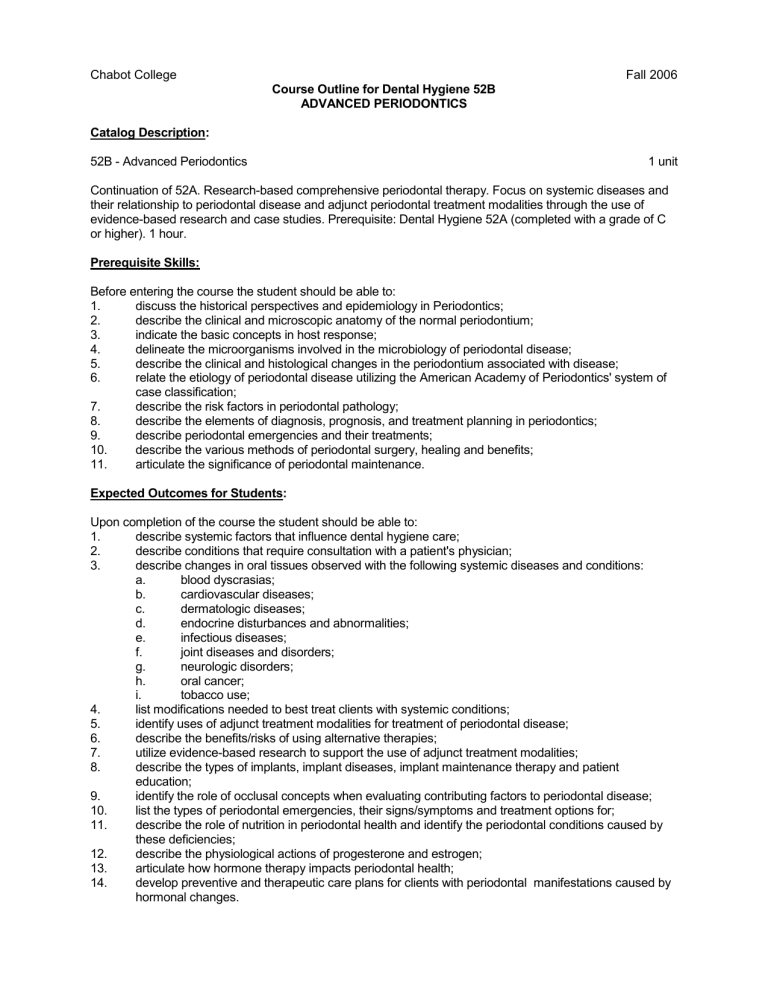
4.
5.
6.
7.
8.
Chabot College Fall 2006
Course Outline for Dental Hygiene 52B
ADVANCED PERIODONTICS
Catalog Description:
52B - Advanced Periodontics 1 unit
Continuation of 52A. Research-based comprehensive periodontal therapy. Focus on systemic diseases and their relationship to periodontal disease and adjunct periodontal treatment modalities through the use of evidence-based research and case studies. Prerequisite: Dental Hygiene 52A (completed with a grade of C or higher). 1 hour.
Prerequisite Skills:
Before entering the course the student should be able to:
1.
2. discuss the historical perspectives and epidemiology in Periodontics; describe the clinical and microscopic anatomy of the normal periodontium;
3.
4.
5.
6.
7.
8.
9. indicate the basic concepts in host response; delineate the microorganisms involved in the microbiology of periodontal disease; describe the clinical and histological changes in the periodontium associated with disease; relate the etiology of periodontal disease utilizing the American Academy of Periodontics' system of case classification; describe the risk factors in periodontal pathology; describe the elements of diagnosis, prognosis, and treatment planning in periodontics; describe periodontal emergencies and their treatments;
10.
11. describe the various methods of periodontal surgery, healing and benefits; articulate the significance of periodontal maintenance.
Expected Outcomes for Students:
Upon completion of the course the student should be able to:
1.
2. describe systemic factors that influence dental hygiene care; describe conditions that require consultation with a patient's physician;
3. describe changes in oral tissues observed with the following systemic diseases and conditions: a. blood dyscrasias; b. cardiovascular diseases;
9.
10.
11.
12.
13.
14. c. d. e. f. g. dermatologic diseases; endocrine disturbances and abnormalities; infectious diseases; joint diseases and disorders; neurologic disorders; h. i. oral cancer; tobacco use; list modifications needed to best treat clients with systemic conditions; identify uses of adjunct treatment modalities for treatment of periodontal disease; describe the benefits/risks of using alternative therapies; utilize evidence-based research to support the use of adjunct treatment modalities; describe the types of implants, implant diseases, implant maintenance therapy and patient education; identify the role of occlusal concepts when evaluating contributing factors to periodontal disease; list the types of periodontal emergencies, their signs/symptoms and treatment options for; describe the role of nutrition in periodontal health and identify the periodontal conditions caused by these deficiencies; describe the physiological actions of progesterone and estrogen; articulate how hormone therapy impacts periodontal health; develop preventive and therapeutic care plans for clients with periodontal manifestations caused by hormonal changes.
Chabot College
Course Outline for Dental Hygiene 52B, Page 2
Fall 2006
Course Content:
1.
2.
Role of systemic disease in periodontitis
Cardiovascular disease: a. Hypertension
3.
4. b. c. d. e.
Coronary artery disease
Valvular heart disease
Cardiac arrhythmias
Anticoagulant therapy
Autoimmune diseases: a. Connective tissue, rheumatoid, osteoarthritis, lupus, scleroderma, sjogren’s b. Skin – psoriasis, pemphigus, pemphigoid
Endocrine disturbances/abnormalities
5.
6.
7. a. b. c. d.
Diabetes
Pregnancy
Hormone therapy
Thyroid disorders e. Adrenal gland disorders
Infectious diseases a. b.
Viral hepatitis
Acquired immune deficiency syndrome c. d.
Herpes simplex
Human papilloma virus e. Tuberculosis
Oral cancer
Blood dyscrasias a. Aplastic anemia b. c.
Agranulocytosis
Cyclic neutropenia
8. d. Leukemias
Neurologic disorders a. Phenytonin - influence on gingival enlargement b. c. d. e. f.
Stroke
Motor system
Periphenal neuropathies
Demylinating diseases
Seizures
9.
10.
11.
12.
13. g. Dementia
Tobacco use and periodontal disease
Alternative periodontal therapies a. Use of antimicrobials b. Use of antibiotics
Implants and periodontal therapy
Occlusion and periodontal conditions
Periodontal emergencies
14. Vitamin deficiencies in the development of periodontal diseases
Methods of Presentation:
1.
2.
3.
Lecture, PowerPoint presentation
Discussion
Case studies, group presentations
Chabot College
Course Outline for Dental Hygiene 52B, Page 3
Fall 2006
Assignments and Methods of Evaluating Student Progress:
1. Typical Assignments a. Analyze case documentations for a periodontally advanced case type b. Evaluate a research article focusing on periodontal therapy/treatment modalities. c. Develop qualitative research project on periodontal diseases
2. Methods of Evaluating Student Progress a. Class participation b. c. c.
Quizzes
Midterm examination
Final examination
Textbook(s)(Typical):
Dental Management of the Medically Compromised Patient, James Little, et al, Mosby’s, 2002 or most recent edition
Foundations of Periodontics for the Dental Hygienist, Nield-Gehrig Willmann, 2004 or most recent edition
Special Student Materials:
Diskettes jg/tsp, G:\Course Outlines\2005-2006\DH 52B
Revised: 4/14/05
